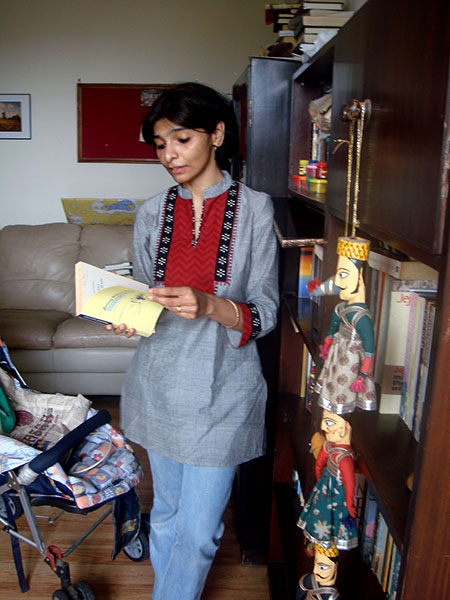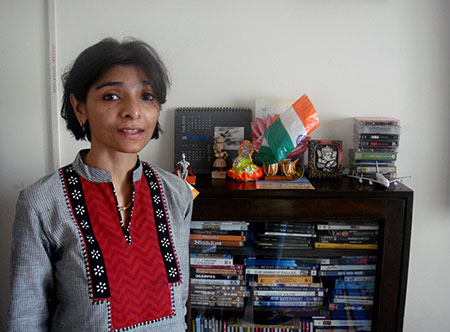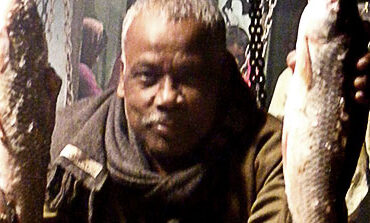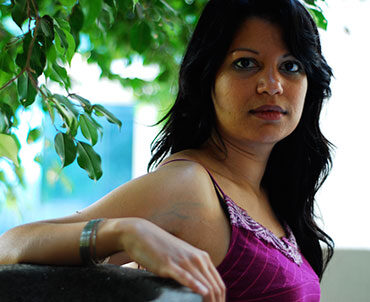I exit the elevator and hurriedly search for house number 604. I’m late. I press a bell, the door opens. A small lady with wavy black curls greets me with a big namaste and a bigger smile. I immediately recognise her as Gauri, writer Anuradha Kumar’s trusted friend and helper, acknowledged on the last page of The Dollmakers’ Island.
Next to greet me are a series of dolls and puppets, sprawled comfortably over most of the living room furniture. But where is Anu Kumar? I see a petite figure running helter-skelter, immediately trying to make me feel at home after my long journey to Gurgaon. We are finally seated among the many dolls and puppets and the interview begins—

The dolls are all ears. Photograph by Tanvi Srivastava.
You studied History at Lady Shri Ram College (New Delhi), management at X.L.R.I. (Jamshedpur), and worked for the Economic and Political Weekly. How and when did writing come into the picture?
I am not sure any more. I was a closet writer for a long time. I moved ten jobs in four years in the corporate world. I would generally write out of boredom. There were all these web sites I came across, such as [that of] the Commonwealth Broadcasting Association. They had a competition where you had to write a short story in under 500 words, which could be read aloud in less than three minutes. I won that in 2004 and the dream/ambition only grew.
You’ve written and published five books in five years. That’s a remarkable feat. Do you have a daily writing schedule?
I write when I am not doing the usual chores or errands, mostly related to my daughter. And I fanatically try and write something at least. I am always afraid that if I miss this, I will forget to write. All the words will disappear somehow. When I was writing Letters for Paul, I was still working full time. I would wake up at four in the morning just to write.
Atisa and the Seven Wonders is a book for children. Letters for Paul, your debut novel, is intended for adults. Who would you describe as the intended audience for The Dollmakers’ Island? Do you prefer writing for children or adults?
Well, The Dollmakers’ Island is like a puzzle. Anyone who likes putting complicated pieces together would like the book. Writing for children or for older readers offers different kinds of experiences, and you learn from both. The books I wrote for young adults/children had some parameters built in, in terms of how long they should be, the tenor they should take, etc. With the other books for the older reader, I always discovered more about the story as I wrote it, so it was like going on an exciting journey. After some time, you find some other part of the story can be more exciting, some characters begin to speak to you, and you fall in love with characters you never intended to make much of in the beginning!
Imagine I’m sitting next to you on a plane. I ask you what you do for a living. You tell me you’re an author and you’ve recently published a book. I look pleasantly surprised and ask you what your book is about. How do you respond?
(Laughs) Okay, it’s a fun book, a satire, and also a love story. It’s about an island that wants to tell its own story, that has its own history. But all this is drowned by a ‘bigger’ history. And so this lady trapped on the island decides to tell the island’s story in very subversive ways, and in the process, she also reaches out to the man she loves.
In the book many things get lost: Leela’s voice, the boat, the ladder. Does the metaphor of being lost have any particular significance to you?
Yes, you know there was this island so keenly watched over and monitored, so there was almost something subversive, willful about all these things getting lost. Almost like an act of rebellion. I was also fascinated by the theme of loss—we never know how, when we come to lose certain things. We are losing stuff every day and the very innocuousness of this loss doesn’t really bother anyone. Maybe quite rightly, too.
On the cover of the book, the bold, drop-shadowed ‘ISLAND’ leaps out at you in a menacing way. In fact, there are several menacing or alienating elements in the novel, especially in the fluidity or lack of fixedness of everything. This is heightened by the many failed attempts to draw straight, fixed lines by authority figures. It honestly disturbed me. Was that your intention?
I guess so. I mean it came out like that (Smiles). It does have that unsettled look, but in the end, some basic things triumph—the Dollmakers tell their stories through Leela, and then her love lasts till the end [of the book] and perhaps even after.
The Island, according to me, is set somewhere in the Sunderbans, an area famous for for its ever changing landscape. Why this setting? Did you visit the area?
I’ve been reading up on this area for a long while now. Its history too is so vague, we know little of this part or even the entire northeast. Our history, our perspective is so north-centric really. I loved Amitav Ghosh’s books, The Shadow Lines, The Hungry Tide, and The Glass Palace, that were set in around this part. And having said that, my parents come from this part of the world, old East Pakistan. Some parts of the story—the river’s fluidity and moodiness—I remember from my father’s stories. Not that he ever told me such stories in detail but there are images that lingered.

Author Anuradha Kumar. Photograph by Tanvi Srivastava.
The narrative structure of the book is remarkably interesting. We have an Orwellian, government-regimented present in Leela’s story, which is interspersed by past narratives of famous historical figures, including everyone from Ashoka to Mir Jahan to Lord Mountbatten. The past and present are linked, through myths, stories, and history. Why did you choose such a complicated structure? Was it difficult to plan?
The book actually began as a realistic short story based on an aunt of mine, who was not called Leela. (Laughs) All my relatives will kill me! It gradually grew but the focus was more on Leela’s story, how she manages to reach out to her love despite everything, and largely through a virtual, unreal medium.
I got feedback from people who read the manuscript, even publishers who later may have rejected the book, and I realised that the history bits appeared really interesting. I put in more of those bits, and then everything fell into a pattern. It took me eight rewrites to get the book to its final form.
My one criticism of the book is that it is too short. Most chapters are only two or three pages long. In my opinion, the characters, especially from the past, aren’t given enough time to develop. Your thoughts?
I would have liked to, really. But the feedback of the manuscript of my first novel (Letters for Paul) was that it needed cutting down, trimming, tightening. So I was always wary of making a manuscript [that was] too bulky and meandering. Also because of the narrative I chose, I had to make it a quick read. I was afraid my readers would lose the various links; lose interest generally.
The last chapter of the book is when the past and the present collide. Shyam’s play is described as “a historical farce”. Could that be an accurate meta-description of The Dollmakers’ Island?
Yes, actually. Even my editor thought that; quite apt too.
I read a quote somewhere in reference to Roald Dahl that writers who write for children are usually the most seditious. True?
What a wonderful thing to say. But yes, when you write for children, and if you are established, you can get away with wild sweeps of the imagination. That could easily stretch into subversion as well.
Any tips for new writers on getting published?
Oh, just write, write everyday, whatever you want to write about. And then get someone who really cares for you to read it. When writing Letters for Paul, I approached Kiran Nagarkar, who was amazingly kind. That’s the first thing, to find someone who is critical and cares—without telling you to junk the story. He told me to find someone who makes you really angry and write about them. Every writer has their hang-ups and for me that was my mom. Poor mom. (Laughs) When I wrote Letters for Paul, I was taking out my angst against my mother.
Do you have any new books in the oven?
The second Atisa book is due out shortly from Penguin. It’s set in the times of Harshavardhan of Kannauj and has Atisa coming to the rescue of the Chinese monk, Hiuen Tsang, time and time again. I had an exciting time working on this book.
Also, there’s going to be a dramatisation based on The Dollmakers’ Island by Akshara Theatre, Jalabala Vaidya, and Sunit Tandon in early September.









“management at X.L.R.I. (Mumbai)”
Mumbai? Didn’t know XLRI shifted it’s base from Jamshedpur to Mumbai :-)
Looking forward to reading this book and the second Atisa book.
The Dollmakers’ Island is a fantastic book. Kumar has matured as a writer over the years. Its interesting how she can switch from serious fiction to children’s books.
I finished the book in two setting, I look to more books from Anuradha Kumar.
Mrs Oobe
A very interesting interview – getting the facts without sounding tedious! Look forward to the book!